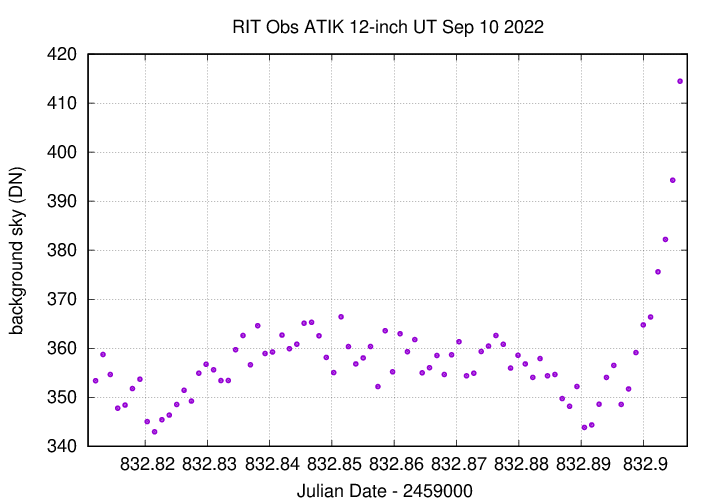
On the night of Sep 09/10, 2022, I observed the eclipsing binary star V1004 Cyg and the RR Lyrae star XX And, for the capstone projects of two students. These are our first observations of XX And.
We acquired images of the eclipsing binary system V1004 Cyg as part of a capstone project.
The main setup was:
Notes from the night:
The object is located at
RA = 19:50:29.44 Dec = +33:08:32.2 (J2000)
A chart of the field is shown below. The size of the chart is about 31 x 26 arcminutes.

I've marked the location of several comparison stars as well. You can find reference magnitudes for these stars at the AAVSO:
I used to use the star marked as "C" in the picture above, or "118" in the AAVSO charts, to shift the instrumental magnitudes to the standard scale.
I took a photo of the finder TV's screen when pointing to this target; this could be a useful reference for the future:

The sky value shows a pretty steady value, rising only as the target set in the west.

The FWHM graph below shows a slightly rising value, with outliers due to trailing.

Using aperture photometry with a radius of 5 pixels in B and V (binned 2x2, each pixel is 1.24 arcsec, so a radius of 6.1 arcsec), I measured the instrumental magnitudes of a number of reference stars and the target. Following the procedures outlined by Kent Honeycutt's article on inhomogeneous ensemble photometry, I used all stars available in each image to define a reference frame, and measured each star against this frame.
Sigma-vs-mag plots show that the floor was about 0.008 mag in V; the floor was about 0.020 mag in B. Hmmm. I may need to be more careful in analyzing B-band frames in the future.

The change in zeropoint shows small variations, possibly due to light clouds.

Photometry shows that we just missed the primary minimum at the start of the run. As seen in other recent observations, the old ephemeris doesn't work very well.

The star XX And is a variable star of the RR Lyr "AB" type. Its period may be changing slightly on long timescales -- that will be one focus of our study of it.
The object is located at
RA = 01:17:27.41 Dec = +38:57:02.0 (J2000)
A chart of the field is shown below. The size of the chart is about 31 x 26 arcminutes.

I've marked the location of several comparison stars as well. You can find reference magnitudes for these stars at the AAVSO:
I'm not sure yet which reference star(s) might be best to shift the instrumental magnitudes to the standard scale. These might be good choices:
| Label | B | V |
| C = 111 | 11.575 | 11.101 |
| E = 117 | 12.503 | 11.745 |
I need to take a photo of the finder TV screen.
The sky value shows a pretty steady value, rising only as dawn approached.

The FWHM graph below shows a steady value (not surprising, as the temperature did not drop much over the last few hours of the night).

Using aperture photometry with a radius of 5 and 7 pixels in B and V, respectively, (binned 2x2, each pixel is 1.24 arcsec, so a radius of 6.1 and 8.7 arcsec), I measured the instrumental magnitudes of a number of reference stars and the target. Following the procedures outlined by Kent Honeycutt's article on inhomogeneous ensemble photometry, I used all stars available in each image to define a reference frame, and measured each star against this frame.
Sigma-vs-mag plots show that the floor was about 0.006 mag in V, and 0.007 in B.

The change in zeropoint shows a rise as the object passed the zenith and started to fall into the west.

Photometry shows the star fading in a steady manner over the 2 hours of the run.
